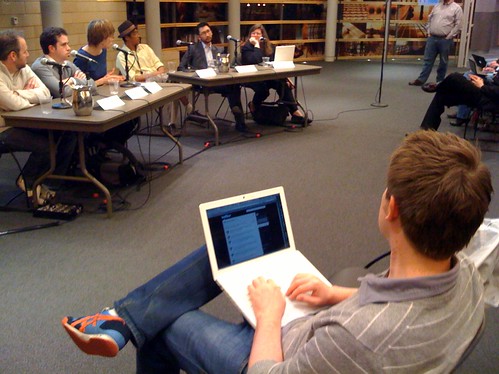Here are some things I've done:That's what I've done for starters. As you can see, most of this costs nothing or next to nothing. I'm a BIG believer in just getting out and meeting people. Thinking I might have an afternoon at a coffee shop and invite people to come by and chat. Maybe buy a round of lattes.
- Print business cards and hand them out. LOTS of them. I print them on my inkjet and give them away to people I meet in the neighborhood. Or leave them at events. No one has refused to take one. It has the blog's name, URL, my phone and e-mail and the blog's Twitter ID. Priceless self-promotion that costs almost nothing.
- Walk the beat. Before July 4, I walked Eastlake Ave., asking businesses if they would be open on the Fourth ... and leaving my business card at every stop. I didn't ask them to buy an ad, just asked if they'd be open and chatted a bit. Did a post about who would be open and, I hope, earned some recognition and street-cred. Wasn't until I'd finished that I realized: Hey! That was a good idea. I just wanted to get the story.
- Sponsor a community event. I was a sponsor for last Saturday's Eastlake Movie Night. Didn't cost me much. I provided tons of publicity on the blog. The site was listed on the poster for the event, which was nice but not required. Helped set up and take down. Handed out business cards. Do something(s) nice for your neighborhood. People will remember. And, it was great fun and I had a blast, which is what matters.
- Go out to coffee with people just for the heck of it with no agenda. Talk about the blog if they like. Ask them what they know that's going on.
- Show up at events. I've started to cover the community council. You get a post out of it and, frequently, tons of tips for other posts. And you meet lots of people. It all helps.
- Get your site on Twitter. It makes a big difference. Follow people in the neighborhood and they'll follow you. Let them know the site is on Twitter (I put it at the top of the blog). When I Tweet a post, it immediately gets good traffic.
- I designed a poster early on (11x14) but haven't printed them (inkjet again) because I wasn't sure it was really worth it. I still might print them. Or not. Not sure it's worth it.
- Walk the beat some more. Showing up in person means a lot to people. They will remember that you came by, asked what was going on, took a photo of an event, wrote a post. They will remember that YOU were there. And you'll get good story ideas out of it.
- Get your posts linked to by other sites. Cultivate contacts at the Times, P-I, Slog and other neighborhood blogs.
Some of this stuff I do for the blog, but most of it I'm doing simply because it's my neighborhood and I'm enjoying helping out and getting to meet people. It's fun!
Also: The blog is EastlakeAve.com.















